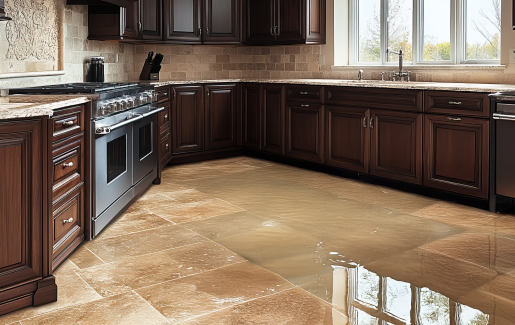Water Loss: Settling a Broken Dishwasher Line
A dream vacation turned into a nightmare when a hidden dishwasher leak flooded a home in West Bloomfield, MI, leaving the owners trapped in a battle with an unresponsive insurer. With mounting frustrations, Globe Midwest™ Adjusters International fought back using expert assessments and strategic negotiations—ultimately securing a settlement nearly double the insurer’s initial offer, restoring their client's home and peace of mind.
Description
While the homeowners were on vacation, a dishwasher line broke and flooded the kitchen of their West Bloomfield residence, leaving up to two inches of standing water. By the time a house sitter discovered the damage nearly a week later, the water had already begun to seep beneath the travertine flooring. The homeowners promptly reported the incident to their insurance carrier, expecting guidance on the next steps.
Instead, months passed without an inspection, estimate, or financial assistance, leaving them in limbo. The insurer placed the burden of proof entirely on the homeowners, refusing to acknowledge potential hidden damage. With no direction or support, they were left to navigate the claim alone while living with a partially functional kitchen and no timeline for repairs.
Issues
1. Delayed Response from Insurer
The insurance company went for months without producing any estimate, stalling the recovery process and leaving the homeowners in limbo. This prolonged lack of communication created ongoing uncertainty and forced them to endure damaged kitchen conditions indefinitely.
2. Dispute Over Floor Damage
The carrier argued that natural travertine flooring was inherently water-resistant, refusing to cover replacement costs for the continuous floor. This stance overlooked the fact that subfloor swelling or cracking could still occur under extensive water intrusion.
3. Undetected Moisture Concerns
Significant water seepage had likely occurred beneath cabinets and between tiles, raising the risk of mold growth and structural deterioration. Without thorough demolition or specialized testing, these concealed areas would remain overlooked and untreated.
4. Outsourcing to Multiple Third Parties
Instead of handling the claim internally, the insurer relied on an independent adjuster and external consultants, creating a fragmented approach. This chain of command blurred accountability and slowed progress, as each party deferred critical decisions.
5. Protracted Negotiations
Even after experts were brought in, the insurer continued debating both the cause and extent of the damage. The prolonged back-and-forth delayed a fair resolution and increased stress for the homeowners, who needed timely repairs.
Solutions Applied
- Engagement of Specialized Experts:
A certified moisture hygienist confirmed the presence of trapped water under the cabinets, while a natural stone specialist assessed damage to the travertine floor. Their professional findings validated the homeowners’ concerns and highlighted the full scope of necessary repairs. - Moisture Mapping & Documentation:
Using advanced detection tools, a precise moisture map was created to show exactly where water had spread. This evidence-based approach weakened the insurer’s argument that water had not significantly impacted hidden areas. - Persistent Communication & Follow-Up:
Regular updates and direct conversations with the insurer kept the claim from stalling further. Maintaining a clear paper trail of all discussions and requests reduced miscommunication and reinforced the urgency of the repairs. - Appraisal Invocation:
When the carrier refused to cover travertine replacement and other key items, the claim moved to appraisal. This formal mechanism forced a thorough review of all documentation and ultimately led the insurance company to negotiate in good faith. - Negotiation of Replacement Costs:
Emphasizing how continuous flooring and cabinetry were interlinked supported the need for full replacement rather than patchwork fixes. Demonstrating the broader implications of water damage strengthened the argument for higher coverage amounts.
Outcome
Through detailed inspections, specialized reports, and the appraisal process, the final settlement reached just under $150,000—nearly double the insurer’s initial $85,000 offer. This amount allowed the homeowners to replace the damaged cabinets, subfloor, and continuous flooring, ultimately restoring full functionality to their kitchen without incurring excessive out-of-pocket costs.

